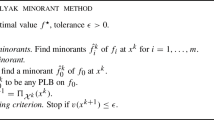Abstract
The so called Modified Hung—Rom Algorithm, based upon theoretical considerations of Hirsch-paths, seems to be one of the most efficient algorithms for assignment problems. Since any two basic feasible solutions to a linear problem can always be connected with a short simplex path passing through the infeasible region, development of algorithms based upon theoretical considerations on infeasible paths seems to be of great practical interest. This paper presents an algorithm of this kind for assignment problems.
Similar content being viewed by others
References
M.L. Balinski, “The Hirsch conjecture for dual transportation polyhedra,”Mathematics of Operations Research 9 (1984) 629–633.
M.L. Balinski, “Signature methods for the assignment problem,”Operations Research 33 (1985) 527–536.
M.L. Balinski, “A competitive (dual) simplex method for the assignment problem,”Mathematical Programming 34 (1986) 125–141.
R. Barr, F. Glover and D. Klingman, “The alternating path basis algorithm for the assignment problem,”Mathematical Programming 13 (1977) 1–13.
W.H. Cunningham, “A network simplex method,”Mathematical Programming 11 (1976) 105–116.
G.B. Dantzig,Linear Programming and Extensions (Princeton University Press, Princeton, NJ, 1963).
G.B. Dantzig, “Eight unsolved problems from mathematical programming,”Bulletin of the American Mathematical Society 70 (1964) 499–500.
L.R. Ford and D.R. Fulkerson, “Constructing maximal dynamic flows from static flows,”Operations Research 6 (1958) 419–433.
L.R. Ford and D.R. Fulkerson,Flows in Networks (Princeton University Press, Princeton, NJ, 1962).
M.L. Fredman and R.E. Tarjan, “Fibonacci heaps and their uses in network optimization algorithms,”25th IEEE Symposium on Foundations of Computer Science (1984) 338–346.
M.S. Hung and W.O. Rom, “Solving the assignment problem by relaxation,”Operations Research 28 (1980) 969–982.
P. Kleinschmidt, C.W. Lee and H. Schannath, “Transportation problems which can be solved by the use of Hirsch-paths for the dual problems,”Mathematical Programming 37 (1987) 153–168.
K. Paparrizos, “A non-dual signature method for the assignment problem and a generalization of the dual simplex method for the transportation problem,”RAIRO Operations Research 22 (1988) 269–289.
P.M. White, A.S. Caplin and L. Van der Heyden, “Scarf's procedure for integer programming and a dual simplex algorithm,”Mathematics of Operations Reseach 10 (1985) 439–449.
Author information
Authors and Affiliations
Rights and permissions
About this article
Cite this article
Paparrizos, K. An infeasible (exterior point) simplex algorithm for assignment problems. Mathematical Programming 51, 45–54 (1991). https://doi.org/10.1007/BF01586925
Received:
Revised:
Issue Date:
DOI: https://doi.org/10.1007/BF01586925




